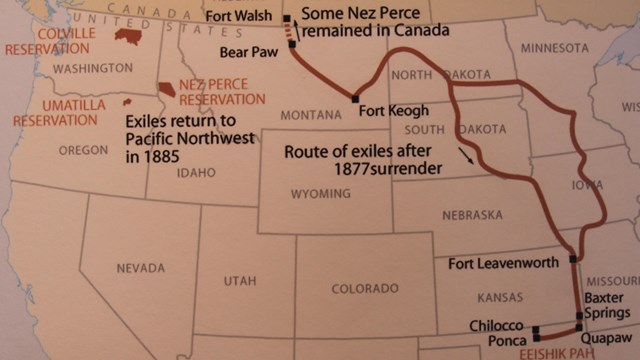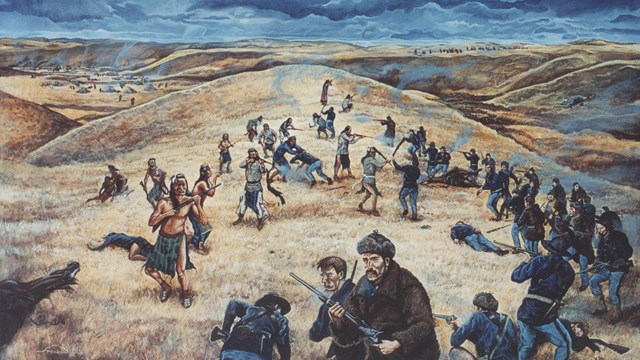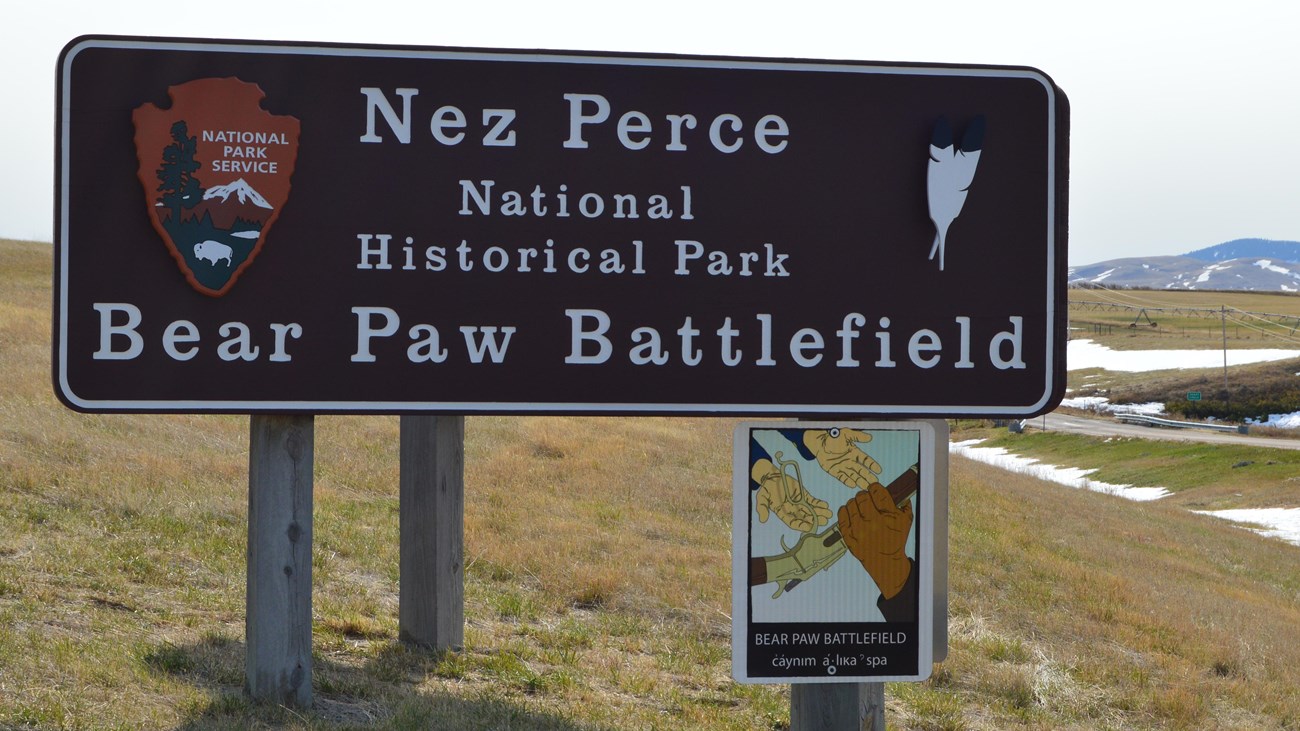|
The Bear Paw Battlefield is the location of the final battle of the Nez Perce Flight of 1877. Following the breakout of war in Idaho, approximately 800 nimíipuu (Nez Perce) spent a long and arduous summer fleeing U.S. Army troops first toward Crow allies and then toward refuge in Canada. After the skirmishes at Canyon Creek, the nimíipuu arrived at C’aynnim Alikinwaaspa (Place of the Manure Fire, now known as the Bear Paw Battlefield), a mere forty miles short of the Canadian border. Following a five-day battle and siege, the nimíipuu ceased fighting at Bear Paw on October 5th, 1877, in which Chief Joseph gave his immortal speech: "From where the sun now stands, I will fight no more forever." The Battle at Bear PawSeptember 29, 1877Abundant game and fresh water offered by Snake Creek made C’aynnim Alikinwaaspa a good place to camp and gather supplies. With General Oliver Otis Howard far behind them the nimíipuu thought they had time to rest their weary hearts, bodies, and horses, and to hunt and butcher some bison before the final push to Canada. Their tipis destroyed at Big Hole left little else for protection. The people spent the night huddled in crude lodges and lean-tos, warmed only by blankets and fire pits burning bison dung. September 30, 1877The morning found the non-treaty nimíipuu preparing to break camp and head north. A rider pulled his horse to a halt on the south bluff waving a blanket to warn everyone that soldiers would be upon them in moments. Colonel Nelson Miles commanding 450 men had traveled approximately 260 miles in 9 days in an attempt to intercept the nimíipuu. Some nimíipuu attempted to escape. Warriors rushed to the bluffs above the camp to defend it. Others ran into camp to aid with the defense. The families trapped in camp sought shelter. Some, knowing the horses were critical to their escape, rushed to protect the herd. Black Eagle recalled: "I left going for the horses. I saw our horses not far away. The horses were wise to the shooting and all began to stampede." The attack came in two sweeping wings. The 2nd Cavalry hit the horse herd to the west of camp and in a five mile running battle captured most of the nimíipuu horses. The 7th Cavalry charged directly towards the bluffs above the camp; warriors rose up from just below the edge of the bluff and stopped the charge cold. The fighting was intense with soldiers and warriors locked in close combat. With the aid of the 5th Infantry the soldiers secured the southern bluff but the warriors kept the soldiers from the camp and their families. Though the army was stopped, the nimíipuu suffered serious losses as 26 died the first day including Chiefs Ollikut (Joseph's younger brother) and Lean Elk. As a cold night fell, both forces found themselves in a stalemate. The nimíipuu could not escape without their horses and the soldiers could not dislodge the nimíipuu from the camp. Both sides dug rifle pits and the lines were drawn for a prolonged siege. The nimíipuu families used tu’kes (digging sticks used to harvest camas roots), knives, and trowel bayonets they had captured from the army during earlier engagements to dig shelter pits. October 1, 1877Dawn brought fresh snow on the ground and ice in water buckets. That day under a white flag of truce, Chief Joseph met with Colonel Nelson Miles and both sides ventured forth to gather dead and wounded. At the end of the meeeting, Joseph turned to leave. He was called back by Miles and was placed in chains to use as leverage. Seeing this occur the nimíipuu made Lieutenant Jerome, who was very close to their camp on reconnaissance, a guest of theirs. By his account, he was given food, blanket, shelter, and allowed to move freely about the Nez Perce camp while retaining his pistol. October 2, 1877The prisoners were exchanged and both returned to their home camps. The military supply train arrived with the 12-Pound Napoleon Cannon. Yellow Wolf remembered October 2 as the day Chief Looking Glass was killed. "Some warriors in [this] pit with him saw at a distance a horseback Indian. One pointed and called to Looking Glass, 'Look! A Sioux!" Looking Glass stepped quickly from the pit. Stood on the bluff unprotected. A bullet struck his left forehead and he fell back dead." Looking Glass was hopeful help had come from the camp of Sitting Bull in Canada. October 3, 1877The fighting continued. The army targeted the area where the families were sheltered with cannon fire. October 4, 1877General Howard arrived with a small retinue; as the remainder of his army had already been sent home. This information was not conveyed to the nimíipuu still in camp. As far as they knew, a second army was on its way. October 5, 1877That morning the two remaining hereditary leaders, White Bird and Joseph, met two Nez Perce men from the bands honoring the 1863 treaty, who were following General Howard at that time. They had entered camp to convince the remaining non-treaty nimíipuu to quit fighting. Joseph and Whitebird were told that they would be returned to Idaho, the leaders will not be killed, and, most importantly, that the army wanted to quit fighting. White Bird mistrusted the army's promises and refused to surrender. However, Joseph returned to camp to tell the people that they could be saved by ending the fighting. This important decision was up to each individual. Choices were few and none were favorable. Could the nimíipuu continue the fight? The supply of soldiers was endless. Should the nimíipuu try to escape on foot under cover of darkness through the lands of traditional enemies? Not everyone could make this trip. Many were too weak. Who would care for the elders, children, and wounded? Would they be able to bury their dead? Would they be allowed to go home? At 2pm Joseph met with Miles and Howard, handed over his rifle, and made his now famous speech:
Afterwards, other nimíipuu handed their weapons over to Miles in an understood mutual decision to lay down arms and negotiate peace. As to their destination, Miles told Joseph: "Which is the place that you love to stay in? I want you to tell me, as I have the power to remove these white people, and let you live there." Miles also promised: "I will give half of them [weapons] back to you after awhile." AftermathAll told, over 400 nimíipuu agreed to quit fighting and turn themselves over the military care. Another group of 30 to 50 nimíipuu left with White Bird that night; the last of between 200 and 300 people who did make it to Canada. The 126 day flight was over, but the plight of those capture and those who escaped to Canada was not even halfway over in terms of time and distance. Learn more about what happened next by following the links below. 
Nez Perce Flight of 1877 Aftermath
The nimíipuu were separated after Bear Paw battle, with some being sent to Indian Territory in Oklahoma, and others escaping to Canada. 
The Nez Perce Flight of 1877
In 1877, the non-treaty Nez Perce were forced on a 126-day journey that spanned over 1,170 miles and through four different states. 
Visit the Bear Paw Battlefield
Plan your trip to the site of the Nez Perce Flight of 1877's final battle. Located near Chinook, MT. For More InformationOfficial Bear Paw Battlefield Map and BrochureThe official brochure and map for Bear Paw Battlefield is available for download below. Alternative accessible formats can be provided upon request. Nez Perce Trail Auto TourThe staff at the Nez Perce National Historic Trail have developed auto tours with travel instructions for retracing the route of the Nez Perce along with maps, graphics, and details about the confilct at sites you can see along the way. Download Auto Tour 8 for more details about the Bear Paw Battle. |
Last updated: August 31, 2023
